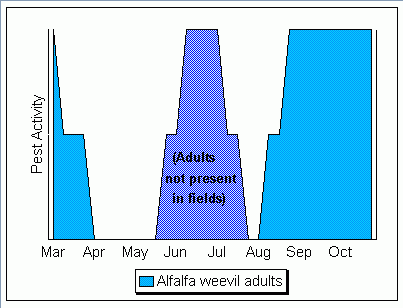Alfalfa Weevil
Alfalfa Weevil
Description
Adult alfalfa weevils are 1/8 to 1/4 inch long, grayish brown to black beetles with a broad dark stripe down the center

Adult alfalfa weevil
of the back. The front of the head extends downward in a distinct snout. Groups of eggs are laid in live and dead alfalfa stems during the fall and spring. The newly-hatched legless, grub-like larvae are pale yellow. They soon become green with a white stripe down the middle of the back. After feeding for about 4 weeks, the full grown larvae spin a net-like spherical cocoon near the top of the plant and pupate. The adults emerge within 10 days. After a short feeding period, they leave the field and spend the hot summer months hidden and inactive. The adults fly back to alfalfa in the fall and remain there over the winter.
Damage
Alfalfa weevil larvae are the most important pest of the first cutting. They feed at the tip of the stem leaving many small rounded holes. Eventually, all of the leaves at the top of the plant may be destroyed. Heavily infested fields take on a bleached out appearance, as seen in the yellow untreated strips in the picture. In addition to reducing yield and quality of the first cutting, the second cutting may be stunted. Larval and adult feeding on the regrowth may set back recovery and development after the first harvest.
Alfalfa Weevil Adult Activity

Larval Activity

IPM Techniques and Scouting Procedures
- The best alfalfa weevil management decisions are based on stem sampling and use of the Tables below. If this information is not available, then control is recommended when 25% to 50% of the tips are being eaten and there are 3 or more larvae per stem.
- Equipment needed: ruler or yardstick, white or yellow plastic 1-gallon bucket, Alfalfa Weevil Pest Management Recommendation Tables, pencil and paper.
- Alfalfa fields should be visited during the week when the degree day accumulation in your area reaches 190. This information is available through your county extension office or the University of Kentucky Agricultural Weather Center alfalfa weevil degree day model. Walk at least 20 paces into the field and check plant tips in several locations for feeding damage and small larvae. If no damage is seen during a careful check, then return in a week. If tip feeding damage and larvae are found, use the procedure below to collect 30 stems and compare your results to the Pest Management Recommendation Table. Follow the directions at the bottom of the chart.
- Take your bucket and walk at least 20 paces into the field before beginning to sample.
- Collect 30 stems while moving through the field in a "U" or "Z" shaped path. Cup your hand around each tip to keep larvae from being knocked from the plant as you break off the stem at the soil surface. Place each stem, tip first, into the bucket. Continue the process, stopping at random spots, until you have 30 stems that come from representative areas of the field.
- Now, select 4 to 5 stems at a time from the 30 stems you collected, and beat them against the inside of the bucket to knock off the weevil larvae. Set the stems aside and continue the process until all of the 30 stems have been shaken.
- Count all of the larvae in the bucket. Look carefully because small larvae are easy to overlook. Record the number found in the 30 stem sample.
- Randomly select 10 of the stems and measure their length to the nearest inch. Calculate the average stem length to see which portion of the chart that you should use. Record the number in the pre-bud, bud or flowering stage.
- Alfalfa weevil pest management recommendation tables are designed to help determine when or if control measures are needed.
References and Additional Information
- IPM-1 Kentucky Alfalfa IPM Manual. 1992.
Current Alfalfa Weevil Degree Day Totals for Kentucky


